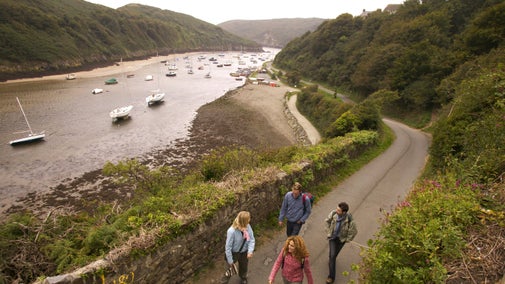
Donate
Everyone needs nature, now more than ever. Donate today and you could help people and nature to thrive at the places we care for.

Southwood was left to us in 2003 as a generous legacy by Mrs Maurer, whose ancestors purchased the estate in the mid-1800s. From the traditional farm buildings to the fields, meadows and heathland, we’ve been working hard to restore the estate back to its former glory.
The historic Grade II listed farmhouse and courtyard required largescale renovation. From re-roofing and whitewashing walls to clearing debris and rebuilding cobbled walkways, there was certainly plenty that kept the team busy.
A key discovery along the way included finding a fascinating piece of Victorian graffiti inscribed on the farmhouse’s attic wall. It’s believed to document the duties of four servants who ‘feathered 26 geese Dec 1878’.
22,860 pieces of slate
8,300 trees planted
12 working holidays
3,500 volunteer hours
650 cups of tea
Thanks to support from the People’s Postcode Lottery, we have also been able to improve landscapes for wildlife at Folkeston, one of five farms making up the 850-acre Southwood Estate.
The farm survived the changes that intensive agriculture has brought, and it presented us with a great opportunity to improve the landscape for people and nature. The ancient wildflower meadows are now alive with bees and butterflies, bluebells drape the fields along the coastal path and flowering hedgerows provide a safe place for rare species of birds, like yellowhammers. This funding was also put to good use improving the landscape at Goodhope Farm near Strumble Head, 15 miles further up the Pembrokeshire Coast.
At Folkeston, the focus is to safeguard the farmland bird species which are present there. According to the 2019 State of Nature report, farmland birds have seen a 54% decline since the 1970s. In Wales alone, the number of yellowhammers has declined 58% since 1995 (State of Birds Wales report 2018) and is now red-listed as a threatened species.

Folkeston’s hedges provide the perfect conditions for many farmland bird species to thrive, including one of Pembrokeshire’s largest remaining yellowhammer populations. Investing in infrastructure, such as fencing and gates, enables us to protect and enhance the network of large hedgerows across the farm, which provide crucial nesting and foraging habitat for these species, as well as creating corridors for wildlife to expand into other parts of the Southwood Estate and neighbouring farmland.
Over the centuries, agricultural improvements were made on the Southwood Estate to increase productivity. We want to provide more space for nature, so our focus since taking on the farm has been to manage the land differently.
One of our biggest achievements has been reintroducing over half a mile of traditional Pembrokeshire hedgebanks around the farm, aided by funding from the SITA Trust. Restoring this lost habitat has been invaluable for wildlife, and we’ve since seen the return of farmland birds, bats using the site for roosting, insects aplenty and burrowing animals enjoying the earthy banks.
The vegetation is also richer, with species including pennywort, foxglove, hawthorn and red campion now visible in the network of hedges.
We’re helping to continue a centuries old farming tradition with our grazing animals, who enjoy a natural grass-based diet from heathland areas while keeping the habitat in good condition.
Without regular grazing, heathland quickly becomes overgrown at the expense of its iconic heathers, flowering plants, insects and birds. Livestock keep the competitive scrub and grasses in check, maintaining open vegetation that is richer for nature.
That’s why you won’t always see our beautiful Welsh Black cattle and Welsh Mountain ponies here at Southwood Farm, as they’re usually out and about grazing our heathland clifftops and commons between St David’s and Fishguard.
Both Welsh Black cattle and Welsh Mountain ponies are known for their hardiness, versatility with all kinds of terrain, self-reliance and placid temperaments. As such, the native breeds are well-suited to our conservation grazing needs.
Our livestock ranger takes care of the herds and to ensure even grazing on heathland across north Pembrokeshire. On average, the cattle and ponies cover 100 hectares of land each year.
We are also working to improve other habitats on the farms, including the wildflower meadows, marshy grassland known as rhos pasture and spring cereal crops.
Fences, gates and water supplies enable us to massively increase the area of land that we can ‘shut up’ for hay or carry out deferred grazing with cattle each year. This has direct benefits for the botanically rich grasslands and rare insects they support, and help us to maintain the coastal bluebell meadows.

Teamwork has made our land management plan possible, with our rangers, volunteer conservation assistants and working holiday groups dedicating their time to deliver for nature.
We want visitors to be able to see our nature-first approach for themselves and enjoy the very best of Southwood’s landscape. That’s why we’ve also opened up a series of public walking trails; choose from a three-and-a-half-mile coastal route or a leisurely one-mile walk.
Preserving Southwood’s past is important to us, but so is safeguarding its future. Your support – whether a visit, a membership or car park donation – means we can continue our vital conservation work and ensure this special place is enjoyed for generations to come.
With your ongoing support, we're able to continue our vital conservation work. Thank you for helping to protect these special places.

Everyone needs nature, now more than ever. Donate today and you could help people and nature to thrive at the places we care for.
Solva’s jutting headlands, gentle valleys and sweeping shores all have a tale to tell. From Iron Age settlements and industry to chilling coastal chronicles, there’s lots to uncover.

A colourful coastline with heaps of history, this pretty peninsula’s been a cultural hotspot for thousands of years. Discover the area’s ancestry, from Celtic life to Wales’ patron saint.
